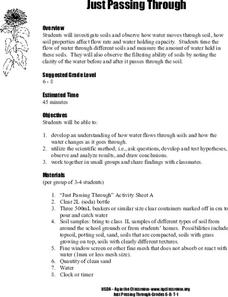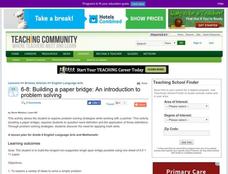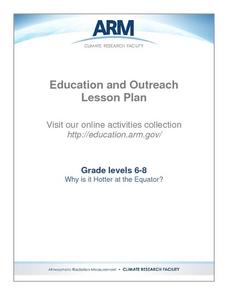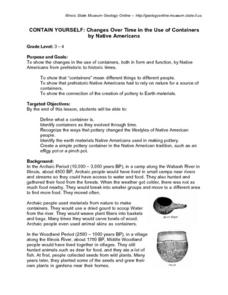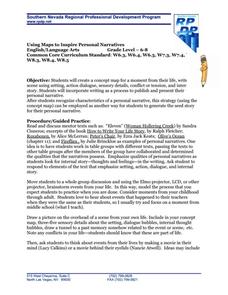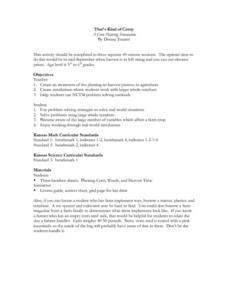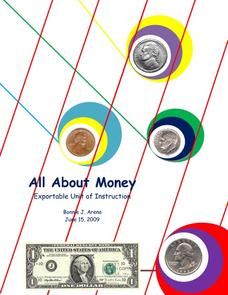Curated OER
Graphing Linear Equations Cards
OK, so maybe graphing linear equations can be fun. This activity includes a set of linear equation cards to be cut and place face up on a table. Learners pick a card and match it to the correct graph card. This is a really fun way to...
Curated OER
Just Passing Through
Young scholars explore how water moves through soil. They experiment with different soil types and record their findings.
Curated OER
Building a Paper Bridge: an Introduction To Problem Solving
Eighth graders explore problem solving strategies to build a paper bridge with a partner. As a class they discuss a variety of techniques to solve a simple problem, then in pairs construct the longest non-supported single span bridge...
Curated OER
Medieval Art
Sixth graders study Gothic architecture on the Internet and create a mug with a gargoyle figure on it.
Curated OER
Why Is It Hotter At the Equator?
Middle schoolers investigate the different heating effects of sunlight. They conduct an experiment that demonstrates the way sunlight strikes the equator, the poles and other parts of the globe.
Curated OER
Contain Yourself: Changes Over Time in the Use of Containers by Native Americans
Learners investigate how Native American containers changed over time and how the use of pottery changed their lifestyle. They create a pottery container.
Curated OER
The Number Match Game
Kindergarteners practice matching words and symbols by playing an index card activity. They create flash cards numbered 0 to 20 and challenge each other in groups to identify the values of the numbers. Learners utilize beans or buttons...
Curated OER
Sports Lesson Plan
Have your class participate in a variety of sports and craft activities using this resource. With sports as the theme, learners work on art projects. Students create soccer ball prints, a three dimensional football, and a sports collage.
Curated OER
Connotation: Three Lessons for Effective Word Choice
Over the course of three days, middle schoolers explore the concept of connotation. They differentiate between the connotative and denotative meanings of sports team names, develop their own team names, logos, and text, and revise a news...
Curated OER
William Shakespeare's Julius Caesar: Fate versus Free Will
Tenth graders explore Shakespeare's Julius Caesar. After reading specific scenes, they brainstorm and discuss free will. Students observe a clip from the Dr. Phil television show entitled, "Afraid to Age" and make connections from the...
Curated OER
Choose Your Words Wisely
Improve word choice! Writers use dictionaries and thesauruses to aid them in choosing exciting words to incorporate in their writing. They rewrite sentences and practice identifying words that can be replaced using a better word....
Curated OER
The Spread of Enlightenment Ideas
Looking for a simple and straightforward reference on the Enlightenment for your young historians? Check out this list of key terms and important figures from the period, followed by a traditional assessment where your learners will be...
Southern Nevada Regional Professional Development Program
Using Maps to Inspire Personal Narratives
A solid description of one way to teach narrative writing, this resource outlines the writing process from concept to completion. Class members create concept maps of moments in their lives and follow the writing process to publish their...
National Council of Teachers of Mathematics
The Roll Out Fractions Game: Comparing Fractions
Reinforce the concept of comparing fractions with a hands-on, two-player game that calls for a visual model, score board, and dice. Players roll dice to acquire their given fraction, create the fraction using fraction tiles, then...
Curated OER
Are You One of Us?
Learners compare and contrast insects and arthropods, identifying characteristics of each. In groups, they sort pictures of arthropods into the five different classes of arthropods. They also sort pictures into insect and non-insect piles.
Curated OER
That's Kind of Corny!
Students apply math skills to determining how much corn seed to plant in 100 acres. They compute the amount of weed killer needed and after totaling how many bushels per acre they harvest, they calculate their profits.
Curated OER
Dissolved Oxygen and Photosynthesis: 1
Students are taught that plants produce oxygen underwater, and they design an experiment that test this question. They discuss whether plants give off oxygen, and how to measure this. Students measure the increase in dissolved oxygen...
Curated OER
How Do Cells Reproduce?
Students examine cell division and the process of mitosis. In this cell reproduction lesson students grow yeast and observe the results, and learn about the career of scientific illustration.
Curated OER
Beginning and Ending Consonants
Young readers explore consonant sounds. In this beginning phonics lesson, learners fill in a beginning/middle/end vertical column chart with the sounds they hear in the pictured object. Practice spelling CVC words.
Curated OER
Introduction to Conics
Just exactly where does the name conic come from? This brief hands-on exploration explains it all. Have your class cut cones to create their own conics, then assess their understanding with a few identification problems. Consider making...
Curated OER
All About Money
Few topics engage young mathematicians as much as learning about money. Through a series of shared readings and hands-on activities, children explore the US currency system, learning how to count money and calculate change as they create...
Orange Public Schools
Stagecraft
The house lights dim, the curtain parts, lights slowly come up, revealing the stage. Before the actors appear, before a word is spoken, the audience is drawn in by the lighting, by the colors, by lines of the set, by the props, and...
Curated OER
Lesson Plan
Young scholars play several activities that allow them to know the terminology used. In this project management instructional activity students create a storyboard.
Curated OER
Talk the Talk
High schoolers interactively learn multimedia terminology while using the Alice Programming. In this multimedia instructional activity students become the director of a movie or video game.

